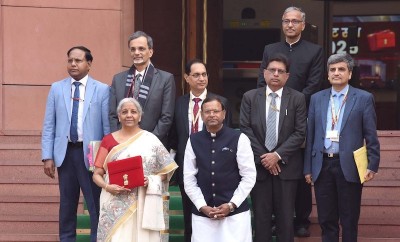 Economic Survey
Economic Survey
Indian economy needs to generate close to 7.85 million jobs annually until 2030 in the non-farm sector, shows Economic Survey
The Indian Economic Survey 2023-24 showed that the Indian economy needs to generate an average of nearly 7.85 million jobs annually until 2030 in the non-farm sector to cater to the rising workforce.
The Survey mentions that there is a scope to supplement the existing schemes of Production Linked Incentive (PLI) (6 million) employment generation over 5 years), MITRA Textile scheme (2 million) employment generation), MUDRA, etc., while boosting their implementation.
While attributing the biggest disruption in the future of work to the accelerated growth in AI, the Economic Survey 2023-24 says that India, with its vast demographic dividend and a very young population, is uniquely situated as AI poses both risk and opportunity.
A particular risk is the BPO sector, where GenAI is revolutionising the performance of routine cognitive tasks through chatbots, and employment in the sector is estimated to decline considerably in the next ten years.
In the following decade, however, gradual diffusion of AI is expected to augment productivity.
But given the affinity of India’s population to work with technology, as seen with the digital public infrastructure, proactive interventions by the Government and industry can position India as a key player in the AI age, the Economic Survey notes.
Highlighting the need for research and development in this sector, the Economic Survey 2023-24 mentions a policy brief which suggests a need for an Inter-Agency Coordination Authority for AI which would act as a central institution guiding the research, decision-making, policy planning on AI and job creation.
The Government has launched several initiatives to ensure an AI enabled ecosystem and to connect AI to the youth of the country. Some of these include ‘Future Skills Prime’, ‘YUVAi: Youth for Unnati and Vikas with AI’ a national programme for school students and ‘Responsible
According to NITI Aayog’s indicative estimates based on national labour force survey data, in 2020–21, 77 lakh (7.7 million) workers were engaged in the gig economy and as per the Economic Survey 2023-24, the gig workforce is expected to expand to 2.35 crore (23.5 million) and form 6.7 per cent per cent of the non-agricultural workforce or 4.1 per cent of the total livelihood in India by 2029–30.
The Survey mentions that the significant contribution in the Indian context and globally has been the creation of effective social security initiatives for gig and platform workers.
The Code on Social Security (2020) marks a significant advancement by expanding the scope of social security benefits to encompass gig and platform workers.
Recognizing the climate change as a hard reality of the present times and projections pointing towards an increase in the frequency and intensity of extreme weather events, the Survey mentions its concomitant outcome as the possible loss of jobs and productivity.
Another aspect of climate change is the efforts to mitigate its impact by adopting green technologies and transitioning to greener energy alternatives.
This trend is leading to businesses witnessing a strong job-creation effect driven by investments that facilitate the green transition of businesses and the application of ESG standards.
The Economic Survey says that India’s corporate sector’s profitability is at a 15-year high in FY24 with profits quadrupling between FY20 and FY23.
It mentions that businesses have an obligation to themselves to strike the right balance between deployment of capital and deployment of labour. In their fascination for AI and fear of erosion of competitiveness, businesses have to bear in mind their responsibility for employment generation and the consequent impact on social stability.
The Economic Survey 2023-24 says that India can utilise the range of products on offer by its different agro-climatic zones and productively engage the sizeable rural workforce, comprising women who seek remunerative part-time employment and educated youth who can be technically skilled to handle small to medium scale agro-processing units.
There remains ample scope for shifting MGNREGS labour to more productive and less fiscally straining ventures.
Low value-addition in agriculture and rising demand for diverse and local food products also provides a good opportunity for India to create more jobs in this sector.
There are also more avenues for captive demand of agro-processed output and the sector can benefit from the synergies between the multiple existing programmes such as Mega Food Park, Skill India, Mudra, one district-one product, etc., for labour, logistics, credit, and marketing.
The care economy holds great importance for a young country like India, which has both demographic and gender dividends to reap.
Highlighting the need to prepare for future care requirements of an ageing population, the Economic Survey 2023-24 says that defining care work is the first step towards acknowledging care as ‘work’.
It mentions that India’s care needs are slated to expand significantly in the next 25 years, as an ageing population follows the ongoing demographic transition while the population of children stays relatively sizeable.
By 2050, the share of children is estimated to decline to 18 per cent (i.e., 30 crore persons), while the proportion of elderly persons would rise to 20.8 per cent (i.e., 34.7 crore persons). Thus, compared to 50.7 crore persons in 2022, the country would need to care for 64.7 crore persons in 2050.
Recognising the disproportionate burden of care on women being consequential to the low Female Labour Force Participation Rate (FLFPR) across the world, including India, the Survey also lays emphasis on ensuring equal opportunity for females by decoupling gender and unpaid care work.
The economic value of developing a care sector is twofold – increasing FLFPR and promoting a promising sector for output and job creation.
The Survey mentions that in case of India, direct public investment equivalent to 2 per cent of GDP has the potential to generate 11 million jobs, nearly 70 per cent of which will go to women.
The care responsibility associated with an increasingly older population necessitates formulating a future-ready wholesome elderly care policy with the Survey mentioning the care economy as a top-tier entry in India’s to-do list for becoming a developed nation by 2047.
According to the Asian Development Bank report, utilising this ‘silver dividend’ of untapped work capacity of population aged 60-69 years is estimated to increase GDP by an average of 1.5 per cent for Asian economies.
Support Our Journalism
We cannot do without you.. your contribution supports unbiased journalism
IBNS is not driven by any ism- not wokeism, not racism, not skewed secularism, not hyper right-wing or left liberal ideals, nor by any hardline religious beliefs or hyper nationalism. We want to serve you good old objective news, as they are. We do not judge or preach. We let people decide for themselves. We only try to present factual and well-sourced news.







